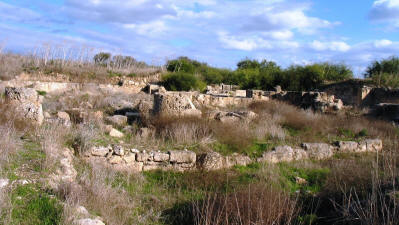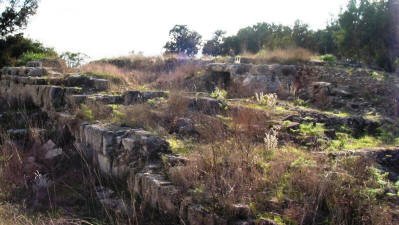The Temple of Zeus Salaminios
Salamis, Near Famagusta, North Cyprus
The temple of Zeus is to the south of the Agora, and once again little excavation has been undertaken, so you will have to use your imagination.
The temple was reputedly built by Teucer, the founder of Salamis, but it was not until the Hellenistic period that the temple was given monumental form, as the rulers sought to consolidate their control of the island in the 3rd and 2nd centuries BC. The primacy of the temple was confirmed during the Roman period by Tacitus, the historian and senator, who records that in 22AD, the emperor Augustus granted the temple the right to grant asylum.
 |
| The Temple of Zeus |
Over the next two hundred years, the cult of Zeus increasingly became associated with the island's identity as a Roman territory. The remains of the temple that we can see today, are from this Roman period.
After the earthquakes of 76 and 77AD, restoration of the city was begun under Augustus, and continued under Trajan and Hadrian. Throughout this period, the city's ceremonial focus was the sanctuary of Zeus. The cult later was joined with the imperial family, and the image of Zeus appeared prominently on Roman coins.
The later history of the complex is less clear. Records of the life of the saints, suggest that relations among the different religious communities were relatively relaxed, and without the violent confrontations seen elsewhere. Bishop Epiphanios is known to have had contact with the remnants of the polytheist community of Salamis at a time when the Zeus temple had already passed from use. The moments of sharpest conflict belong to the later years of the 4th century, when the emperor Theodosius began vigorously to promote the church and close the temples.
 |
| The Temple of Zeus |
The Zeus temple apparently passed out of service around the mid 300s, shortly before the building of the great basilica, later dedicated to Bishop (later saint) Epiphanios, which after 400 became the new civic and religious focus of the city. It would appear that the cult of Zeus gradually lost its vitality leading up to this period.
During the earthquakes of the 4th century, the temple was badly damaged, and restoration was not part of the plans of Constantine for the restoration of his provincial capital.
The temple precinct was identified in the late 19th century, and a brief excavation was undertaken in the 1970s. During the excavations, inscriptions were found, honouring Livia, the wife of Augustus, and dedicating the temple to Zeus Salaminios
Its plan featured a raised temple that stood at the end of a vast porticoed court. The temple was built of local limestone. It stood on a high podium measuring about 28m by 22m. the porch was decorated by twelve freestanding columns. A stepped ramp reached from the temple to the court with its flanking Corinthian porticoes, which seem to have functioned as part of the sanctuary. The entire complex measured 250m long by 60m wide, and would have dominated the city of Salamis.
See the location in Google maps.
Return to Salamis Index, or Famagusta Index.